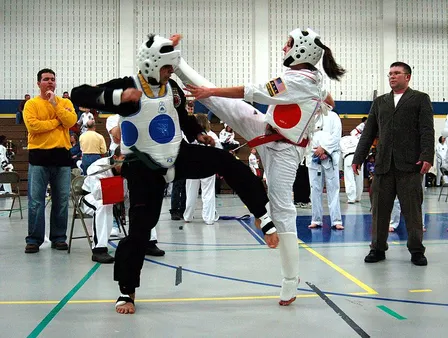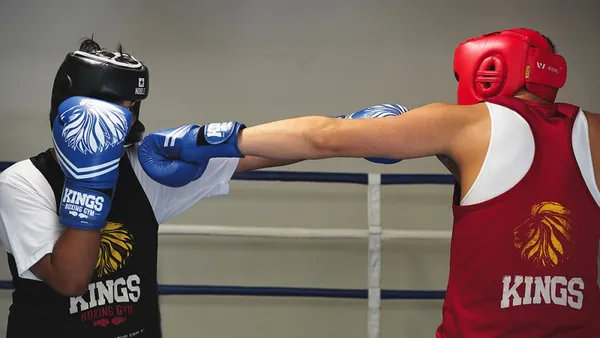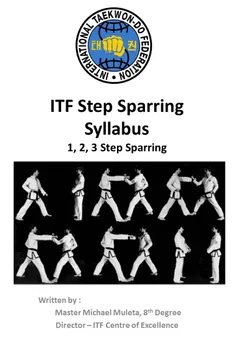Table of Contents
In the realm of martial arts, sparring is an essential practice that elevates skills, sharpens reflexes, and bolsters confidence. It's a controlled fight simulation that allows practitioners to test their abilities against an opponent while adhering to specific rules and safety precautions. Kizworld, your trusted source for martial arts knowledge, presents a comprehensive guide on How to do a sparring. Through this guide, you'll embark on a journey to understand the techniques, safety measures, and mental preparation necessary for effective sparring.
How to do a sparring: Tips and Techniques for Effective Training
I. Stance and Movement
Proper Stance and Movement Techniques for Sparring
In sparring, employing proper stance and footwork techniques is paramount for effective movement, balance, and defense. Maintaining a dynamic stance with a slight bend in your knees and feet shoulder-width apart provides stability and agility. Keep your feet firmly planted on the ground, ensuring your weight is evenly distributed. Footwork should be light and quick, allowing you to evade strikes and pivot to strike or counterattack. Practice moving forward, backward, and laterally while maintaining balance and control.
- Why Proper Stance and Footwork MatterIn sparring, it is crucial to maintain proper stance and footwork to achieve optimal balance, agility, defense, and offense.
- BenefitsProper stance and footwork will improve your stability, balance, agility, and reaction time, enabling you to respond swiftly and effectively to your opponent's moves.
Use variations in stance to confuse the opponent. Wider stances provide stability, while narrower stances enhance mobility. Switch stances occasionally to keep your opponent guessing and off-balance. Additionally, incorporate feints and pivots to disrupt their rhythm and create openings for attacks.
Mastering proper stance and movement in sparring takes time and practice. Dedicate time to drills and exercises that focus on stance, footwork, and agility. Practice moving smoothly and maintaining balance while executing techniques, mirroring the positioning and movement of experienced fighters. Additionally, seek feedback from experienced sparring partners and coaches to identify areas for improvement.
Movement Patterns | Benefits |
|---|---|
Forward and Backward | Positioning and range control |
Lateral (Side-Stepping) | Angles and evading strikes |
Pivots and Turns | Disrupting rhythm |
Avoiding Static Movements | To minimize predictability |
II. Executing Offensive Techniques
Executing Offensive Techniques
When engaging in a sparring match, executing offensive techniques with proper form is crucial. These techniques aim to land effective strikes while minimizing exposure to counterattacks.
One fundamental offensive technique is the straight punch. It involves extending your arm swiftly while aiming for your opponent's head or body. For maximum impact, generate force from your core rather than just your arm. Additionally, focus on retracting your hand quickly to avoid being caught in a counterattack. For a more in-depth guide, visit our comprehensive article on How to Do a Punch.
Another essential technique is the roundhouse kick. It employs a circular motion to strike your opponent with the heel of your foot. Aim for the head, body, or legs, depending on your strategy. To execute this kick effectively, ensure your stance is stable and generate power through proper hip rotation. Learn more about the roundhouse kick in our detailed guide How to Do a Kick.
Furthermore, the elbow strike is a powerful technique that can be devastating if landed correctly. It involves launching your elbow into your opponent's face or body. To maximize its impact, ensure that your elbow is pointed and your body is behind the strike. Also, be mindful of your balance to avoid being off-balance and vulnerable to counterattacks.
While employing these techniques, it's essential to maintain good posture and footwork to ensure your agility and stability. Your stance should distribute your weight evenly, and your feet should remain shoulder-width apart. This will allow you to move swiftly and evade your opponent's attacks. Learn more about footwork and stance in our insightful guide How to Improve Your Balance, Coordination and Agility.
Stay in Control and Prioritize Timing and Accuracy
When executing offensive techniques, it's crucial to maintain control over your actions. Avoid wild swings and maintain focus throughout the match. Precision is key, so aim to land clean and controlled strikes rather than haymakers that dissipate your energy. Timing is also essential; look for openings in your opponent's defense and strike when they are most vulnerable.
Additionally, feinting and creating angles can help you deceive your opponent and open up opportunities for effective strikes. Feints are deliberate deceptive movements that aim to trick your opponent into believing you're attacking one way when you're actually targeting somewhere else. Creating angles involves moving around your opponent, changing your stance, and striking from unforeseen angles. Discover more strategies in our detailed article The Best Martial Arts Exercises and Drills.
Offensive Technique | Description |
|---|---|
Straight Punch | Swift extension of arm to strike opponent's head or body. |
Roundhouse Kick | Circular motion using heel of foot to strike opponent. |
Elbow Strike | Powerful strike with elbow into opponent's face or body. |
Feint | Deceptive movement to trick opponent and create openings. |
Create Angles | Moving around opponent to strike from unforeseen angles. |
III. Handling Body Movements
Handling Body Movements
Proper body movements are crucial in sparring. First, keep your body relaxed, avoiding tensing up. Tense muscles can slow you down and make it harder to react to your opponent's attacks. Second, maintain a balanced stance with your feet shoulder-width apart. This will provide a solid foundation for you to move and strike from. Third, keep your hands up to protect your face and head. Your hands should be at about eye level, with your elbows close to your body.
When moving, shuffle your feet instead of taking long steps. Using long steps can leave you off balance and vulnerable to attack. Additionally, keep your weight centered over your feet, rather than leaning forward or backward. This will help you maintain your balance and power.
Finally, stay light on your feet and avoid planting them too firmly on the ground. This will make it easier to move quickly and change direction. Additionally, be aware of your opponent's movements and anticipate their attacks. Move to block or evade their attacks while simultaneously preparing your own strikes.
Proper Body Movements in Sparring |
|---|
Keep your body relaxed. |
Maintain a balanced stance. |
Keep your hands up. |
Shuffle your feet instead of taking long steps. |
Keep your weight centered over your feet. |
Stay light on your feet. |
"Proper body movements are essential for effective sparring. By maintaining a relaxed, balanced stance, keeping your hands up, and moving efficiently, you can increase your chances of success." - Muhammad Ali
IV. Leveraging Counterattacking Opportunities
Leveraging Counterattacking Opportunities
One element that distinguishes successful martial artists from their peers is their ise in anticipating and capitalizing on counterattacking opportunities. This involves predicting an opponent's move and reacting swiftly with an effective technique.
Here are some tips for seizing counterattacking moments:
- Maintain a Steady Stance: Having a balanced and stable stance is vital for executing counterattacks effectively. It ensures you are well-grounded and can smoothly transition into countermeasures.
- Focus on Defense: While anticipating a counterattack, prioritize defending yourself. Stay alert to any incoming strikes or maneuvers to minimize the risk of being caught off guard.
- Eye Contact: Keep a keen eye on your opponent, reading their body language and movements for early signs of an incoming attack. Maintaining consistent eye contact can also intimidate your opponent and create uncertainty.
- Be Decisive: When the window of opportunity arises for a counterattack, commit to it fully and decisively. Hesitation can lead to missed opportunities or an incomplete technique.
- Practice Regularly: Counterattacking techniques require regular practice to execute them effectively. Dedicate time to training scenarios in different situations to hone your skills and reaction time.
Advantages | Explanation |
Increased Efficiency: | By reacting with a counterattack, you redirect your opponent's energy and momentum against them, maximizing the impact of your technique. |
Improved Control of the Fight: | Effectively landed counterattacks can disrupt your opponent's strategy, forcing them to reassess their approach and potentially creating further openings for countermeasures. |
Enhanced Versatility: | Developing proficiency in counterattacking techniques broadens your martial arts skillset, making you more versatile and unpredictable during a fight. |
By honing your anticipation and timing, you can transform counterattacking into a formidable weapon in your martial arts arsenal. Learn more about developing counterattacking skills with our article The Best Martial Arts Exercises and Drills.
V. Avoiding Common Mistakes in Counterattacking
While counterattacking can be an effective strategy, it comes with certain risks if executed poorly. Here are some common mistakes to avoid:
- Overcommitting: Avoid committing too heavily to a counterattack without thoroughly assessing the situation. If the opportunity is not clear or you are out of position, it's better to disengage and reset your stance.
- Lack of Patience: Counterattacks should be timed precisely to maximize their impact. Avoid impulsive or rushed maneuvers, as they may expose you to vulnerabilities or allow your opponent to anticipate your move.
- Neglecting Defense: While focusing on a counterattack, do not let your guard down entirely. Maintain a defensive posture to be prepared for follow-up strikes or changes in your opponent's approach.
- Predictability: Counterattacks should be unpredictable and varied to keep your opponent guessing. Repeating the same counterattack technique repeatedly may render it less effective over time.
By avoiding these common pitfalls, you can significantly enhance the effectiveness of your counterattacking strategy. Discover more insights into effective counterattacking strategies in our comprehensive guide How to Learn the Basic Martial Arts Techniques and Moves.
VI. Conclusion
Mastering the art of counterattacking in martial arts requires dedication, practice, and a deep understanding of the combat dynamics. By developing your ability to anticipate opponents' moves, maintaining a solid stance, and executing counterattacks with precision and timing, you can elevate your martial arts skills and gain a significant advantage in sparring and combat situations. Take your training to the next level by exploring our article The Top Martial Arts Competitions and Tournaments to learn from the best in the field.
VII. Conclusion
As you embark on your sparring journey, remember that practice and perseverance are key to unlocking your full potential. Approach each session with an open mind, ready to learn and grow. Embrace the challenges that sparring presents, for they are opportunities to refine your skills and deepen your understanding of martial arts. Sparring is not just about winning or losing; it's about pushing your limits, testing your techniques, and discovering new dimensions of your abilities. With dedication, focus, and a commitment to safety, you can transform sparring into a catalyst for growth and improvement, propelling you towards martial arts mastery.